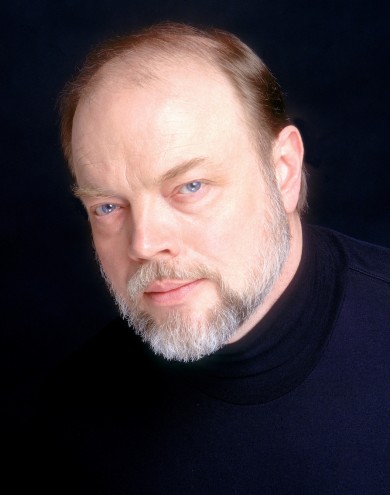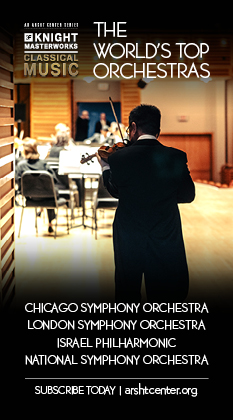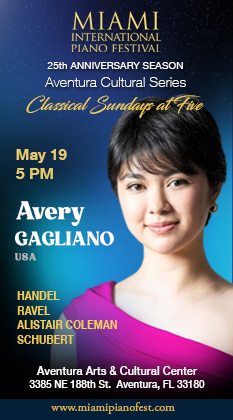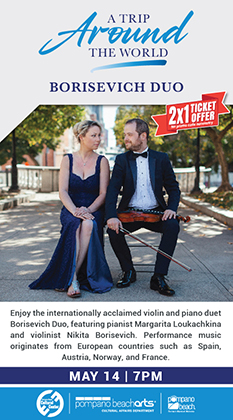Singers provide a riveting night of opera with New World Symphony in “Bluebeard’s Castle”

Michelle DeYoung sings the role of Judith in the New World Symphony's performances of Bartok's "Duke Bluebeard's Castle." Photo: Christian Steiner
Instruments of torture, precious gems and a dark journey into the interior of a twisted, lonely soul took up the evening Friday in Miami Beach, as the New World Symphony performed Bartók’s opera Duke Bluebeard’s Castle.
Based on a 17th-century French folk tale, the composer’s only opera tells the story of the nobleman Bluebeard, a man whose past is rich in horrors, as his inquisitive new wife demands the keys to seven locked doors in his castle. The orchestra, led by Michael Tilson Thomas, brought in world-class soloists for the two roles, the mezzo-soprano Michelle DeYoung, and the bass Eric Halfvarson. And the performance marked the U. S. premiere of a production directed by the London-based video artist Nick Hillel, whose work was projected on screens built into New World Center.
The videos did not take the obvious path of showing castle walls, heavy wooden doors and iron locks. Instead, beginning with images of bare branches and water droplets, they showed close-in, almost abstract images to illustrate the wonders and horrors revealed as the doors opened: spikes and hooks tearing through fabric for Bluebeard’s torture chamber, glittering geometric shapes for the treasure room, tight shots of flowers for Bluebeard’s secret garden.
If the video presentation wasn’t the fantastically imaginative work it could have been, it also wasn’t a distraction from the music and action of the opera. On a black stage mounted above and behind the orchestra, Halfvarson and DeYoung, brought rich voices of enormous depth and an electric tension to the performance, showing how much drama can be achieved without expensive sets and huge casts.

Eric Halfvarson sings the role of Bluebeard in Bartok's opera. Photo: Lisa Kohler
A commanding figure in a black cape and salt-and-pepper beard, Halfvarson, known for some of the more intimidating Wagner and Verdi roles, brought not only power but pathos to the role of the terrifying nobleman. He could be dignified and stentorian, when displaying the realm over which he rules, ominous when singing of the gloomy castle’s secrets, terrifying when urging Judith to stop asking for the keys to the doors. Yet throughout there was an underlying sadness at his own intimidating power and awful past, and even when he sang softly–asking Judith toward the end to simply love him and ask no more questions—his voice, with its biting articulation, radiated force.
As Judith, DeYoung maneuvered finely between expressing love for Bluebeard and a fatal curiosity to knew his secrets. Vocally she gained in strength as she bent Bluebeard to her will, forcing him to hand over the keys to door after door. At the end, when she learns her fate, her voices rings with fear, and finally, resignation. For sheer vocal heft and dramatic power, she held up well against Halfvarson and the orchestra.
Unlike most opera singers, who must make themselves heard above a medium-sized pit orchestra, Halfvarson and DeYoung were up against the massed forces of the New World Symphony. There were a few moments when the orchestra overpowered them, particularly Halfvarson, but Bartók’s score makes the orchestra as important as the singers, and under Tilson Thomas, the ensemble gave a distinguished performance that brought out the varied moods and colors of this atmospheric score.
A dark, foreboding tone prevailed, with finely handled work in Bartók’s running figures in the lower strings. There were richly colored solos in the oboe, as Judith sings of the weeping castle, and the flute, as the opening of the fourth door allows the sunshine of Bluebeard’s garden to stream in. And when the fifth door opens, revealing the vastness of Bluebeard’s realm, the orchestra burst into a magnificent outpouring of symphonic sound.
The opera, which only lasts about an hour, took up the second half of the program. For the first half, members of the orchestra performed Bartók’s String Quartet No. 6.
The quartet consisted of violinists Jeannette Jang and Vivek Jayaraman, violist Anthony Parce and cellist David Meyer. The musicians brought great precision and transparency of texture to the first movement. They played with rhythmic vigor in the march-like second movement, and invested the dance-like third, with a lightness that allowed all instruments to be heard but with overlying sense of melodic and harmonic direction. The finely balanced intensity was manifest in the ensuing slow movement.
String quartets aren’t often paired with operas, but this was a highly successful performance, one of the tightest, and most intense chamber performances by the New World musicians over the last two seasons.
The New World Symphony’s production of Bartók’s Bluebeard’s Castle repeats 7:30 p.m. Saturday. nws.edu, 800-597-3331.
Posted in Performances
Leave a Comment
Sat Apr 28, 2012
at 1:58 pm
No Comments




